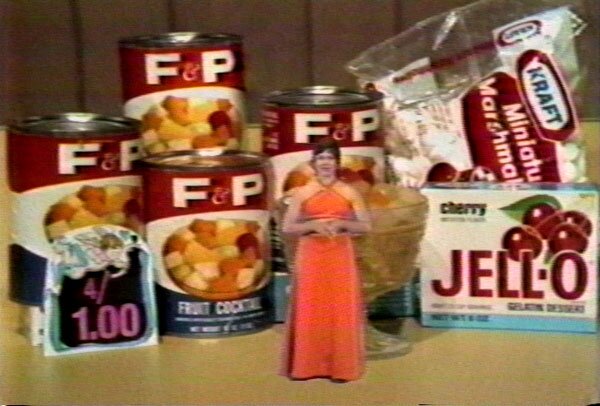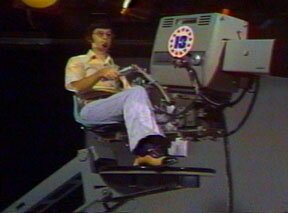|
Studio 13 |
A Publix commercial produced in Studio B (1972)
It took a lot of light and smooth blue backings to create a successful Chroma Key effect. Note that the woman pitching Jello and fruit cocktail casts no shadow because the switcher could not 'clip' subtle shades at the time.
In between live programming, Channel 13's studio crew would be used for commercial production (Publix Supermarkets were a weekly client) or the recording of public service shows such as "College Kaleidoscope" or "High-Q." , Since Studio A was dedicated to Pulse news, all studio production occurred in Studio B. The main drawback was that PULSE news aired live at noon, six, and eleven pm, leaving only 3 to 4 hours of production time between newscasts and often interrupting production.
To create an entire separate production capability, Studio 13 was built behind the station adjacent to the former film lab.
Studio 13 (1976)
Note one PC-70 on a Vinten crane, the other on a Vinten pedestal.
Both cameras were equipped with servo Angienoux zoom lenses
Studio 13 had a modest size stage, about 50' by 50', and used the mobile unit's Norelco PC-70s. Vinten pedestals were imported from England, finally permitting a camera move that combined the ability to dolly, boom up or down, and zoom all at the same time.
Who's that on the crane? Yikes, it's me! Dig those crazy shoes.
A small studio crane was also employed, capable of shooting from a low height of 3', and a maximum height of 8'. A complete new lighting package was installed along with a shop for set construction.****
A sophisticated Ampex editing controller was installed with 3 new Ampex AVR3 quad VTRs, under the control of Studio 13's engineer Bill Napier. The first regular program produced out of Studio 13 was "McKay," a weekly sports program hosted by Andy Hardy and The Tampa Bay Bucs original coach, John McCay. Studio 13 was used sporadically for the first few months, with little revenue to show for the cost of construction. Competition from startup production companies may have doomed the venture a couple of years down the road.
****One of the more serious drawbacks at Channel 13 during the 1970's was the lack of a respectable scenic and prop department.


